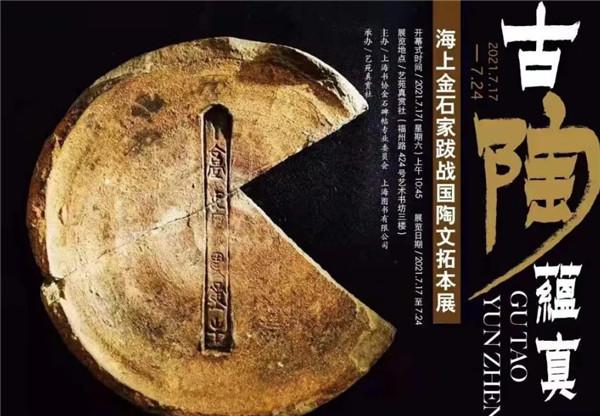Next year will mark the 150th anniversary of the discovery of ancient pottery. Last weekend, the Jinshi family and scholars on the sea gathered at the Yiyuan True Appreciation Society on Fuzhou Road to participate in the largest ancient pottery rubbing exhibition in recent years, "Ancient Pottery Yunzhen - Maritime Golden Stone Family Trek Warring States Tao Wen Tuoben Exhibition". Scholars issued an initiative at the symposium on the same day, hoping to pay attention to and study the aesthetic characteristics of ancient pottery at present through this exhibition, and explore more hidden values.

Illustration: Exhibition poster Official picture
Small fragments support history
In the pottery fragments, there are many hidden historical evidence, in front of the famous Haipai Jinshi wu Zijian, calligrapher and painter Lian Liang Baowen's "Xianze Jiguang" this work, Fudan University excavated literature and ancient script research center Director Liu Zhao introduced that in the Spring and Autumn Warring States period, with the seal on the unburned ceramic pottery foundation, such an imprint was formed. Taking this rubbing as an example, according to the chronology, it is calculated that it was the Yan kingdom in 239 BC, "Right Yin" refers to the institution that made pottery at that time, and "Yin" is the official title of the overseer, representing him responsible for supervising the manufacture of this batch of pottery.
Picture: "Yoshimitsu Senzawa" official picture
The pottery inscribed with ancient pottery was originally not a work of art, but a daily necessity. The ancient pottery written in the big seal resembles today's trademark, representing the identity of the makers and their credibility. If there is a quality problem with the product, then as early as the Warring States period, the ancestors established a responsibility tracing system, and this tracing system is called "Wule Gong Name".
Ancient pottery was often used to store grain. Before Qin Shi Huang unified weights and measures, each country had national weights and measures standards, and there were special agencies to produce this type of standard. The rubbings are diverse in form and rich in content, and intuitively record the place names, personal names and the system of workers and officials at that time.
There are many historical knowledge points hidden in Tao Wentuo's films, such as the lunar calendar in some parts of China during the Warring States period, which is counted in 13 months, and many Chinese characters are still unrecognizable in their meaning... These puzzles need to be studied and solved by archaeologists.
Picture: Warring States Pottery Rubbings Official Map
Save a study of a righteous deed
At the exhibition site, the exquisite rubbings are inscribed by the top Jinshi artists and calligraphers in contemporary China, which are very structured under the illumination of spotlights. In the counter next to it, there are fragments of broken ancient pottery lying horizontally and vertically, which are slightly careless and it is very easy to ignore the ornamentation and seal script on them. Preserving and studying these ancient pottery fragments and disseminating the beauty of ancient Chinese characters can be regarded as a righteous deed of the Jinshi family in Shanghai in recent years. "Without the re-affirmation of the great calligraphers and painters, without the examination of paleographers, these fragments of ancient pottery were abandoned on the side of the road, and no one looked at them more." At the seminar, the salvage value of this exhibition was praised by the academic and artistic circles.
Picture description: Professor Tang Cuncai introduces the work Official picture
In this exhibition, the "strongest lineup" of maritime Jinshi masters, including Han Tianheng, Chen Mingwu, Tong Yanfang, Wu Zijian, Liu Yiwen, Sun Weizu and other 40 old, middle-aged and young three-generation Jinshi families, who used ancient pottery as the inscription object to show the inheritance of traditional classics and the wisdom and choice of breaking through the artistic fence of today's Haipai Jinshijia. The Jinshi family selected the pottery pieces and then rubbed them, and the rubbings were attached with calligraphy inscriptions and seals. The inscription is an evaluation of the source, origin, and content of the work - since the Ming and Qing dynasties, this kind of "literati play" has prevailed to this day.
The rubbings and inscriptions of ancient pottery are not as numerous as the rubbings of Yantai, Wadang, bronze, etc., first, because the amount of ancient pottery is small, and second, the Chinese characters on the top are so long ago that it is difficult to identify, even in the Ming and Qing dynasties. But for the literati since the Ming and Qing dynasties, all the rubbings with Chinese characters and patterns were willing to fiddle with them.
Tang Cuncai, the organizer of the event and director of the Professional Committee of the Shanghai Book Association's Golden Stone Inscriptions, said that the study of ancient pottery was an important event in the academic and artistic circles of the late Qing Dynasty, and this exhibition hopes to further promote the art of Haipai golden stone and calligraphy and seal engraving in inheriting classics and exploring innovative paths. (Xinmin Evening News reporter Le Mengrong)